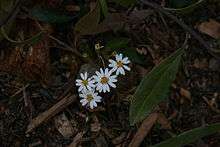Olearia elliptica
| Olearia elliptica | |
|---|---|
 | |
| Scientific classification | |
| Kingdom: | Plantae |
| (unranked): | Angiosperms |
| (unranked): | Eudicots |
| (unranked): | Asterids |
| Order: | Asterales |
| Family: | Asteraceae |
| Tribe: | Astereae |
| Genus: | Olearia |
| Species: | O. elliptica |
| Binomial name | |
| Olearia elliptica DC.[1] | |
Olearia elliptica, commonly known as the sticky daisy bush, is a shrub in the Asteraceae family native to New South Wales and Queensland in eastern Australia.[2] It was named by Augustin Pyramus de Candolle in 1836.[1] The subspecies praetermissa is endemic to Lord Howe Island.[3]
It grows as a shrub to 2 m (6.6 ft) high.The leaves are arranged alternately along the stems, and measure 2–11.5 cm (0.79–4.53 in) long and 0.5–3.8 cm wide. The flowerheads appear from November to May and are arranged in corymbs. The individual flowerheads are 1.1 to 2.6 cm in diameter, with 8 to 23 white ray florets and 8 to 30 yellow disc florets.[2]
The range is from Berry northwards along central and eastern New South Wales to the Queensland border.[2] It is found in areas of annual rainfall of over 900 mm in the Sydney Basin.[4]
It adapts readily to cultivation, preferring acidic soils in part shade or sun.[3]
References
- 1 2 "Olearia elliptica DC.". Australian Plant Name Index (APNI), IBIS database. Centre for Plant Biodiversity Research, Australian Government.
- 1 2 3 Lander, N.S. "New South Wales Flora Online: Olearia elliptica". Royal Botanic Gardens & Domain Trust, Sydney, Australia.
- 1 2 Elliot, Rodger W.; Jones, David L.; Blake, Trevor (1997). Encyclopaedia of Australian Plants Suitable for Cultivation:Volume 7 – N-Po. Port Melbourne: Lothian Press. pp. 74–75. ISBN 0-85091-634-8.
- ↑ Benson, Doug; McDougall, Lyn (1994). "Ecology of Sydney Plant Species Part 2: Dicotyledon families Asteraceae to Buddlejaceae" (PDF). Cunninghamia. 3 (4): 789–1004. ISSN 0727-9620.